Hubbard, Chicago Warted - Winter Squash
Price: $3.45
SKU: 3370181115 days - Also known as 'Green Warted Hubbard', the fifteen to eighteen foot vines of 'Chicago Warted Hubbard' are very vigorous and produce dark-green, hard shelled, heavily warted fruit that weigh up to sixteen pounds. With some care, they can store into late spring and are good for pies, baking and freezing.
'Chicago Warted Hubbard' was bred by the Budlong Gardens of Chicago from the original 'Hubbard' and was introduced in 1894 by Vaughan's Seed Store of Chicago.[1]
Here in the Maritime Northwest, it is common to plant seeds in hills. The hills are created by mounding up the soil about four to six inches high, twenty-four inches across at the base and flattened on the top. This allows the soil to be better warmed by the sun and provides better protection from heavy rain.
Sow five to six seeds, one inch deep, in hills or rows. Spacing is dependent on plant type. Vining varieties should be spaced on six foot centers while bush-types at twenty-four to thirty inches apart. When seeds germinate, cut off all but the strongest three or four seedlings.
When laying out your garden, remember to consider the growing habits of the varieties that you are planting. Some bush-types are compact while some vining types require a tremendous amount of space. Harvest time will also vary by type.
Informational References:
- "Vegetables of New York: The Cucurbits," New York Agricultural Experiment Station, 1935, pgs. 19-20.
- "List of American Varieties of Vegetables for the Years 1901 and 1902," by W. W. Tracy, Jr., USDA, 1903





